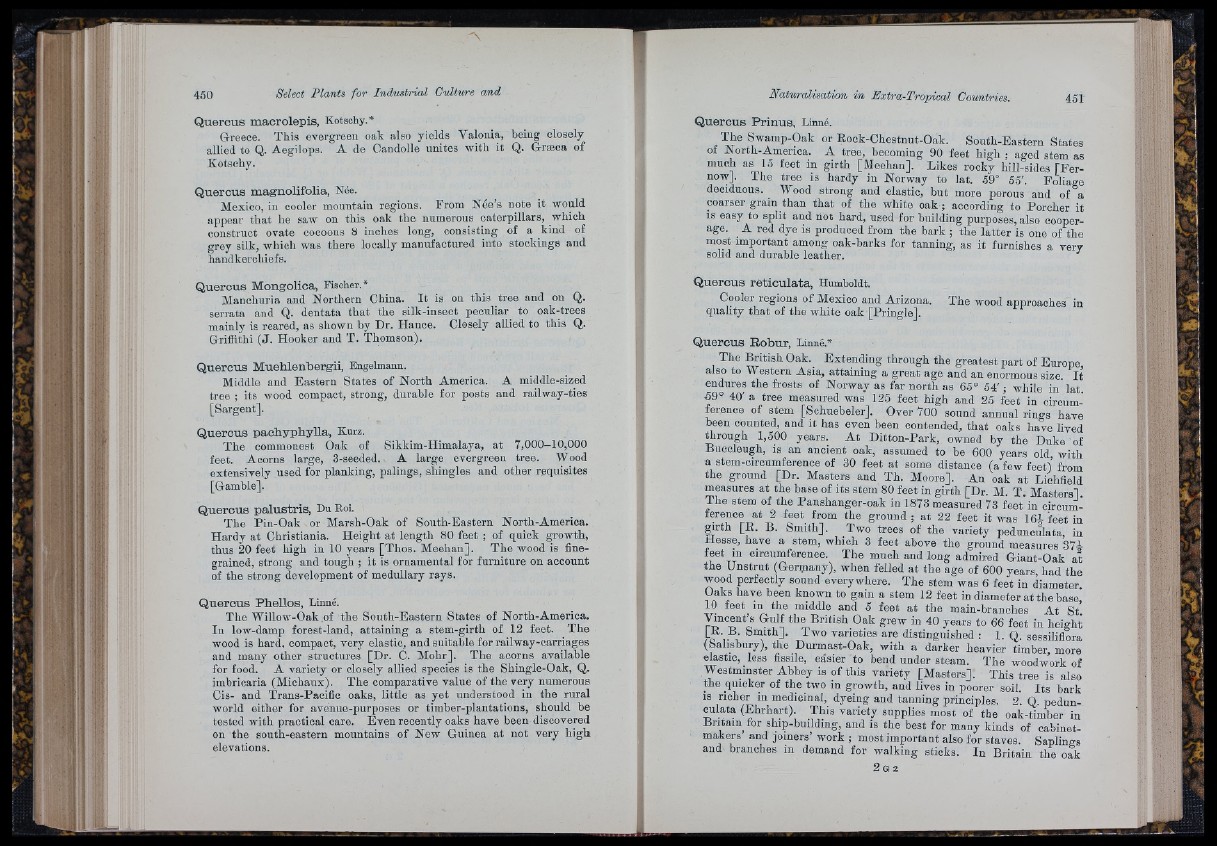
Naturalisation in Extra-Tropical Countries. 451
Ii
;
Quercus macrolepis, Kotschy.*
Greece. This evergreen oak also yields Valonia, being closely
allied to Q. Aegilops. A de Candolle unites with it Q. Græca of
Kotschy.
Quercus magnolifolia, Née.
Mexico, in cooler mountain regions. From Nee’s note it would
appear th a t he saw on this oak the numerous caterpillars, which
construct ovate cocoons 8 inches long, consisting of a kind of
grey silk, which was there locally manufactured into stockings and
handkercliiefs.
Quercus Mongolica, Fischer.*
Manchuria and Northern China. I t is on this tree and on Q.
serrata and Q. dentata that the silk-insect peculiar to oakYrees
mainly is reared, as shown by Dr. Hance. Closely allied to this Q.
Griffithi (J . Hooker and T. Thomson).
Quercus Muehlenbergii, Engelmann.
Middle and Eastern States of North America. A middle-sized
tree ; its wood compact, strong, durable for posts and railway-ties
[Sargent].
Quercus pachyphylla, Kurz.
The commonest Oak of Sikkim-Himalaya, a t 7,000-10,000
feet. Acorns large, 3-seeded. A large evergreen tree. Wood
extensively used for planking, palings, shingles and other requisites
[Gamble].
Quercus palustris, Du Roi.
The Pin-Oak or Marsh-Oak of South-Eastern North-America.
Hardy at Christiania. Height a t length 80 feet ; of quick growth,
thus 20 feet high in 10 years [Thos. Meehan]. The wood is finegrained,
strong and tough ; it is ornamental for furniture on account
of the strong development of medullary rays.
Quercus Phellos, Linné.
The Willow-Oak of the South-Eastern States of North-America.
In low-damp forest-land, attaining a stem-girth of 12 feet. The
wood is hard, compact, very elastic, and suitable for railway-carriages
and many other structures [Dr. C. Mohr]. The acorns available
for food. A variety or closely allied species is the Shingle-Oak, Q.
imbricaria (Michaux). The comparative value of the very numerous
Cis- and Trans-Pacific oaks, little as yet understood in the rural
world either for avenue-purposes or timher-plantations, should he
tested with practical care. Even recently oaks have been discovered
on the south-eastern mountains of New Guinea at not very high
elevations.
Quercus Prinus, Linné.
The Swamp-Oak or Rock-Chestnut-Oak. South-Eastern States
of North-America. A tree, becoming 90 feet high ; aged stem as
much as lo feet in girth [Meehan]. Likes rooky hill-sides [F e rnow].
The tree is hardy iu Norway to lat. 59° 55'. F'oliage
deciduous. M’ood strong aud elastic, but more porous and of a
coarser grain than that of the white oak ; according to Porcher it
is easy to split and not hard, used for building purposes, also cooperage.
A red dye is produced from the bark ; the latter is one of the
most important among oak-barks for tanning, as it furnishes a very
solid and durable leather.
Quercus reticulata, Humboldt.
Cooler regions of Mexico and Arizona,
quality th a t of the white oak [Pringle],
The wood approaches in
Quercus Robur, Linné.*
The British Oak. Extending through the greatest part of Europe
also to Western Asia, attaining a great age and an enormous size. I t
endures the frosts of Norway as far north as 65° 54' ; while in lat
59° 40' a tree measured was' 125 feet high and 25 feet in ciroum-'
ference of stem [Schuebeler]. Over 700 sound annual rings have
been counted, aud it has even been contended, that oaks have lived
t r o u g h 1,500 years. A t Ditton-Park, owned by the Duke of
Buccleugh, IS an ancient oak, assumed to be 600 years old, with
a stem-circumference of 30 feet at some distance (a few feet) from
the ground [Dr. Masters and Th. Moore]. An oak at Lichfield
measures a t the base of its stem 80 feet in girth [Dr. M. T. Masters]
The stem of the Panshanger-oak iu 1873 measured 73 feet'in circum!
ference at 2 feet from the ground ; a t 22 feet it was 164 feet in
girth [R. B. Smith]. Two trees of the variety pedunculata, in
Hesse, have a stem, which 3 feet above the ground measures 37L
feet m circumference. The much and long admired Giant-Oak a t
the Unstrut (Germany), when felled at the age of 600 years, had the
wood perfectly sound everywhere. The stem was 6 feet in diameter
Oaks have been known to gain a stem 12 feet in diameter at the base’
1() feet m the middle and 5 feet a t the maiu-brauches A t St
Oak grew in 40 years to 66 feet iu height
[R B Smith]. Two varieties are distinguished : 1. Q. sessiliflora
(Salisbury), the Durmast-Oak, with a darker heavier timber, more
elastic, less fissile, easier to bend under steam. The woodwork of
Westminster Abbey is of this variety [Masters]. This tree is also
the quicker of the two m growth, aud lives in poorer soil. Its bark
IS richer in medicinal, dyeing and tanning principles. 2. Q. pedunculata
(Ehrhart). This variety supplies most of the oak-timber in
Britamqor ship-building, and is the best for many kinds of cabinetmakers
and joiners’ work ; most important also for staves. Saplings
and branches in demand for walking sticks. In Britain the oak
2 G 2